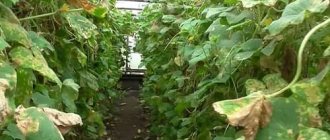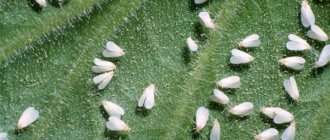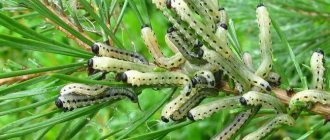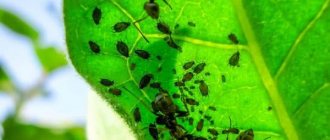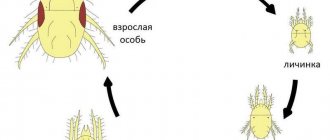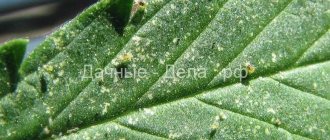Spider mites (Tetranychidae), contrary to popular belief, are not an insect, but an arachnid. This is a large family, comprising 95 genera and more than 1270 species. Many are dangerous pests of ornamental and agricultural crops. Representatives of the family infect various plants by sucking cell sap from leaves, flowers, buds, and young stems. The spider mite on tomatoes belongs to the species Tetranychus urticae and is called Common.
Why is it dangerous?
Photos of spider mites on tomato seedlings show that the parasite is very small in size, so it is difficult to notice it in time. Meanwhile, it causes great damage to plantings - it sucks vitality from the leaves, entangling the shoots with a thin but dense web. As a result, the bushes not only stop receiving enough nutrients from the soil, but also face a lack of sunlight and fresh air.
When tomatoes are densely planted in a greenhouse, spider mites can completely destroy the crop.
Spider mites reproduce in large colonies and can literally cling to tomato bushes. The parasite larvae remain in the soil for a long time and subsequently move on to young seedlings. If you do not fight the pest, it will have a negative impact on greenhouse tomatoes for several years.
Reasons for the appearance of ticks on the site
Typically, spider mites hide in the top layer of soil and in plant debris in garden beds. Sometimes it enters the site together with other crops or through contaminated objects. We can list several main reasons for the appearance of the pest:
- planting tomato seedlings or seeds in contaminated soil that has not undergone antiseptic treatment;
- using dirty garden tools;
- using diseased seeds or purchased seedlings;
- the presence of wildflowers and weeds infected with the pest near the tomatoes.
If you keep the greenhouse clean and at a stable temperature, the likelihood of insects appearing is significantly reduced.
Wintering
Spider mites overwinter in the ground, under the bark of trees and shrubs, and in unharvested plant debris. Even in open soil, the pest is able to withstand temperatures down to -28 °C and not die. In a closed greenhouse, it overwinters as comfortably as possible, since the soil in it usually does not freeze.
With the onset of spring, when the temperature rises to 12 °C, female insects come to the surface of the soil and lay eggs. Hatching spider mites move to tomato seedlings and other plants, after which they also begin the reproduction cycle.
Spreading
At the beginning of spring in a greenhouse, spider mites settle on tomato seedlings and immediately begin to harm young leaves. The blades and stems lose turgor and become watery as the parasite sucks the vital juices out of them.
Over time, spider mites begin to spread throughout the area. From plant to plant, it passes along with other insects or is carried on animal fur, on garden tools, on clothing and on the soles of shoes. In open ground, the spread of the parasite is facilitated by wind and precipitation.
Spider mites can produce up to 18 generations in one season
Favorable conditions
The pest feels most comfortable at an air temperature in the range of 29-31 ° C and at a humidity of 35-55%. In early spring, spider mites develop slowly because they are constrained by weather conditions.
With the onset of final warmth, the parasite begins to actively reproduce and lays new eggs on average every two weeks. The insect's life cycle takes 8-20 days. The rapid spread of the pest is especially facilitated by unsanitary conditions in the greenhouse and dense plantings.
Favorable conditions
Many species of spider mites, including Tetranychus urticae, are well adapted to mid-latitude conditions.
In the Leningrad region, the pest can produce 8-10 generations per year, in the southern part of Russia - 12 generations. The best conditions for the colony are created in greenhouses.
| Factor | Optimal conditions |
| Temperature | The highest rate of tick development is observed at +29…+31°C. The pest loses its ability to reproduce only at temperatures below +12°C. For comparison, at +15°C the egg matures in 15 days, at +30°C this period is reduced to 3 days. |
| Humidity | The parasite prefers dry air (35-55%). In rainy summers, when air humidity is above 60%, colony growth slows down significantly. |
| Weakened plants | A lack of light, nutrition and especially watering reduces the resistance of tomatoes to pest attacks. Sluggish, drooping leaves can be pierced even by weak representatives of the species. |
| Tight fit | In dense plantings, plants not only suffer from a lack of resources, but also come into contact with the tops, which facilitates the spread of the mite. |
| Weeds | Many types of wild grasses can serve as food sources for spider mites. In an overgrown area, arthropods quickly move from one plant to another. |
| Early age of tomatoes | The most vulnerable are young tomatoes, the leaves of which are tender enough that the pest can easily bite through them. |
What do tomatoes affected by spider mites look like?
Signs of spider mites on tomato seedlings are quite characteristic. The presence of a pest is indicated by:
- whitish spots on the veins of leaves and on stems, turning yellow over time;
- deformation of the lower plates along the edges and their subsequent drying out;
- the presence of numerous small grayish lumps on the back of the leaves;
- scanty flowering or its complete absence;
- the presence of a thin web on tomato bushes.
When affected by mites, tomatoes turn yellow, dry out and wither, despite regular watering. The pest sucks the juices out of the plant and does not allow it to develop even with proper care.
When to spray tomatoes against spider mites
The first signs of spider mites appear on tomatoes usually closer to summer, at the end of May or mid-June. During this period, weather favorable for the development of the pest sets in, and it begins active reproduction.
It is recommended to carry out the first treatments of tomatoes against the parasite at the beginning of flowering of the bushes. A single spray is usually not enough. Chemical or traditional insecticides are used every two weeks to reliably stop the reproduction of the insect and prevent it from laying new eggs.
Taking into account temperature when processing plants
The instructions for a number of acaricides state the need for double treatment with the drug. And if you use an acaricide that does not affect pest eggs, you cannot neglect this recommendation. It is necessary to destroy not only adult individuals, but also the future generation, which will soon emerge from the eggs.
At the same time, the interval between treatments in the instructions is given conditionally, while it directly depends on the air temperature. Indeed, with different indicators, the rate of appearance of offspring will be different:
- at a temperature of +20 °C, the interval between treatments is 10 days;
- at +25 °C interval 5 days;
- at +30 °C interval 3 days.
At temperatures below +18 °C, spraying is ineffective, since the active phase of the pests’ life activity is suspended, and they hibernate, hiding in shelters.
Measures to combat spider mites on tomatoes
You can treat tomato seedlings against spider mites in a variety of ways. Chemicals have the most powerful effect. For prevention and with a small number of insects, it is allowed to use folk remedies.
Chemicals
If tomatoes in a greenhouse are severely damaged by spider mites, it makes sense to immediately resort to strong chemicals. Among the most effective, several remedies can be listed:
- Actellik. A broad-spectrum insecticide designed to protect garden crops from most parasites. To use the drug, you need to dilute 2 ml of the working substance in 1 liter of water and spray the plantings.
Actellik is poisonous to pets and humans, so it must be handled with care. - Mites. The product is designed specifically to combat spider mites; it is highly effective and affordable. To use, you need to dilute about 4 ml of the drug in 1 liter of water.
After using Kleschevit on tomatoes, the greenhouse must be properly ventilated. - Oberon Rapid. The insecticidal agent is prepared as follows: 3 ml of the substance is stirred in 1 liter of lukewarm water, and then topped up with clean liquid to 10 liters. The resulting preparation is sprayed on the leaves of tomatoes.
Oberon Rapid also demonstrates good effectiveness against aphids and whiteflies
When using chemical insecticides, it must be taken into account that most of them are highly toxic. The last time tomatoes are sprayed is no later than three weeks before harvest.
Attention! For maximum benefit, chemicals must be applied to tomatoes every two weeks.
Biological products
Biological products are quite effective and rarely harm ripening tomatoes. Therefore, it is recommended to use them during the period of fruit ripening, when the use of chemicals is undesirable:
- Fitoverm. A reliable drug based on aversectin C has pronounced insecticidal properties. To remove spider mites, dilute 10 ml of the product in 1 liter of water and spray the plantings. Particular attention is paid to the underside of the leaves.
Fitoverm should be used for tomatoes 2-3 times per season - Agravertine. An insecticidal biological preparation affects the nervous system of insects and causes paralysis of adults and larvae. To treat tomatoes, you need to dilute 5 ml of the product in 1 liter of water. Spraying is carried out every 2-3 weeks, this is how long the protective effect of the drug lasts.
Agravertine is not toxic to the soil and breaks down into safe components in the soil in two days - Bitoxibacillin. The biological product can be found commercially in the form of a powder or liquid concentrate. To process tomatoes, you need to dilute about 60 g of the active substance in 10 liters of water and mix thoroughly. Spraying is carried out once a week in the morning or evening.
Bitoxibacillin should be used for tomatoes at a temperature of 15-30 ° C
Biological preparations can be used both to prevent spider mites and to eliminate the pest. The products give a good effect if you start processing the plantings on time.
Folk recipes
You can treat tomatoes against spider mites with folk remedies as a preventive measure or for mild infestations. The most popular home remedies are:
- Soap solution. A bar of laundry soap is grated, and then 100 g of shavings are mixed in 1 liter of water. The resulting product is sprayed onto the leaves of the tomatoes, making sure that the liquid does not fall on the ground.
Treatment of tomatoes against spider mites with a soap solution is repeated once every two weeks. - Garlic infusion. About 30 g of crushed heads are poured into a bucket of hot water and left under the lid for a day. After time, the solution is filtered and the tomatoes are sprayed.
To make the garlic infusion last longer on the tomato leaves, you can add a little crushed soap to it. - Decoction of onion peels. About 200 g of purification is poured into 10 liters of liquid, brought to a boil, and then left in a warm place for 12 hours. The strained product is used for spraying over tomato bushes.
Onion decoction is good not only against ticks, but also against aphids and thrips
It is recommended to use folk remedies against spider mites even before the pest appears on the leaves. In this case, they will have a good preventive effect and help completely avoid infection.
Agrotechnical methods
In addition to effective remedies for spider mites on tomatoes, it is recommended to use agricultural techniques aimed at getting rid of the insect:
- dig up the soil and remove all plant debris from the beds in spring and autumn;
- plant plants with a strong smell next to tomatoes - for example, onions, garlic, herbs and spices;
- Inspect your tomatoes regularly to notice the first symptoms of spider mites in time.
When infected bushes appear in the garden or greenhouse, severely damaged plants must be removed from the site. This will protect neighboring plantings from pests. Spider mites on tomatoes are contagious to flowers, so special attention is paid to preventing the parasite if there are flower beds near the tomatoes.
Where do they come from?
Ticks enter homes and infect healthy crops in several ways:
- After a new mite-infested plant appears at home. It is difficult to detect small pests; a newly acquired flower often hides eggs or adults in the crown. All newly arrived plants must be quarantined for 2-4 weeks.
- Contaminated soil. When transplanting and rejuvenating home flowers, you can infect them with mites from the soil. Even purchased land can contain pests.
- Displaying home flowers in gardens, balconies and loggias. A lot of ticks live in vegetable gardens and summer cottages.
- A light, small pest can be carried in by a tailwind from the street, from open transoms and vents. Most flowers are on windowsills or just near windows.
Often the peddlers are old pots taken from storerooms. A person can bring ticks into the house on things and clothing.
Features of treating tomatoes against spider mites in a greenhouse
You can eliminate spider mites on tomato seedlings in a greenhouse using standard methods. But several nuances should be taken into account:
- It is better to immediately remove bushes densely entangled in cobwebs from the greenhouse. Tomatoes grow densely in a greenhouse, so the mite quickly spreads throughout the plantings.
- A good way to prevent pests in a greenhouse is to maintain humidity at about 70%. Spider mites actively reproduce in dry and hot conditions. But it is impossible to over-water the tomatoes to protect them from insects, since in this case the bushes may suffer from fungal diseases.
- After insecticidal treatment, the greenhouse must be properly ventilated. Spraying in a confined space causes a sharp increase in humidity.
To prevent and eliminate spider mites, the soil in the greenhouse at the roots of tomatoes can be sprinkled with garlic or onion gruel. This will help get rid of insects living in the top layer of soil.
Gardening tips
There are four main rules, the implementation of which allows you to annually collect a large number of aromatic tomatoes from the beds:
- variety selection;
- timely control of parasites;
- planting healthy seedlings;
- selection of the appropriate site;
- prevention and maintenance of appropriate care.
All of the above actions help increase crop yields.
Important. Covered tomatoes are more susceptible to spider mite attacks. Is it possible to get a high-quality, decent harvest of tomatoes? Of course, if you listen to the advice of experienced gardeners.
Prevention of infection
Following simple rules of prevention allows you, in principle, to avoid damage to tomatoes by spider mites. When growing tomatoes you need:
- leave sufficient distance between bushes and plant plants at least 25 cm apart from each other;
- regularly weed the beds and eliminate weeds;
- promptly remove dried tops and other plant remains from the site;
- observe crop rotation and do not plant tomatoes in one place for two years in a row.
When growing tomatoes, you need to control the composition of the soil and not apply nitrogen fertilizers too often - they create an environment favorable for the proliferation of the pest. But phosphorus and potassium fertilizers serve as a preventive measure for spider mites, so they should be given special attention.
It is recommended to plant tomatoes in an area where other nightshades have not grown before.
Preventive measures
It is always easier to prevent a pest from appearing than to fight it. Before the start of the planting season, you can already take measures to prevent comfortable conditions for the reproduction of spider mites.
- After harvesting, be sure to remove old tops, withered leaves from trees, weeds with roots, and fruiting residues of various crops from the site. Dig the bed deeply. This way the tick will lose its wintering place.
- Disinfect the soil on which the tick was found with boiling water or an acaricide solution. You can sprinkle it with a bleach solution, then dig it up.
- If the tomato is to be grown in a greenhouse, then it is important to disinfect it with effective means. In the fall, such a closed room can be treated with a smoke bomb.
- Spider mites do not tolerate phosphate fertilizers. Phosphorus fertilizers also help in the fight against harmful insects.
- It is necessary to use nitrogen fertilizing moderately, since excess nitrogen in the soil contributes to the appearance of mites.
- You can alternate planting tomatoes with tick-repellent crops. The pest will not like the proximity to garlic, dill, calendula, chrysanthemum, mustard, celery and basil.
- Before planting, it is better to inspect each seedling and disinfect it. Pest eggs may already be on the seedlings.
- It is important not to plant tomatoes several times in a row in the same place. It is necessary to ensure that there are no crops nearby that are prone to spider mite damage.
- The distance between plantings should be at least 30 cm to ensure normal air movement and complicate the migration of the pest.
- The most unfavorable conditions for the survival of the parasite are humidity above 85% at temperatures up to 25 degrees.
- It is necessary to remove debris near the roots of tomatoes and regularly inspect the plants, turning over the leaf blades, paying close attention to any discoloration or damage to the leaves.
- You can place sticky tape around the bushes to trap pests.
Weakened plants that lack light, water or timely feeding are most susceptible to spider mite attacks. It is important to avoid diseases and mechanical damage to the crop.
